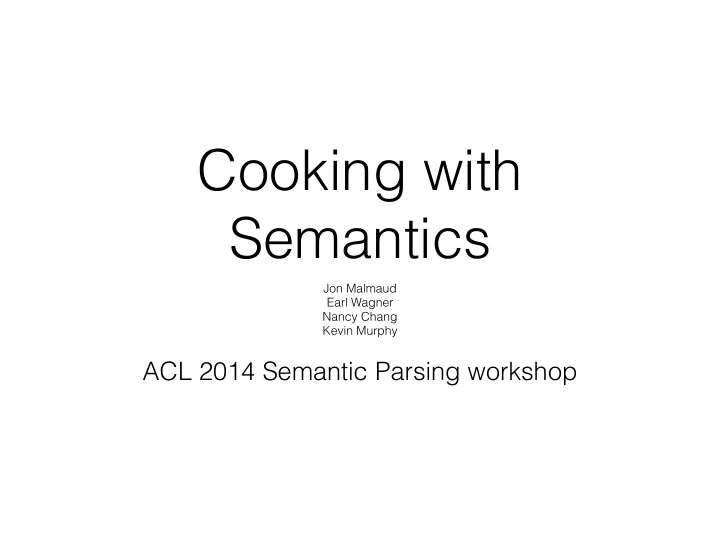

Cooking with Semantics Jon Malmaud Earl Wagner Nancy Chang Kevin Murphy ACL 2014 Semantic Parsing workshop
Overview + applications We want to parse how-to • instructions from the open web Enable smart semantic search • for instructions Improve accuracy of frame- • semantic parsing with ‘common sense’ reasoning based on planning and affordances Aid model-based interpretation • of how-to videos
What makes it hard? Arguments Actions Control • Elided • Ambiguous senses • Conditionals • Implicitly available • Omitted/implied • Sequencing • Incompletely • Alternatives specified
What makes it hard? Arguments Actions Control • Elided � • Ambiguous senses • Conditionals • Implicitly available � • Omitted/implied • Sequencing • Incompletely • Alternatives specified Elided: Pour batter into prepared pans. Bake. Implicitly available: Blend confectioners' sugar, hot water and almond extract in a small bowl.
Our approach Affordances Action ontology Heat � Mix � Fryable(Egg) = 8 -Object � -Location � … Fryable(Milk) = -3 -Method � -Method -Temperature Learned through co-occurance statistics Domain model across the whole web Heat(x::Ingredient): InOven(x) -> IsHeated(x) Mix(x1, x2): ∃ Mixture(x1,x2) Move(x1::Ingredient, x2::Location): In(x1, x2)
Inference Start with two eggs and one cup milk. Fry the eggs. Frame parser Latent state Fry the eggs. Kind Quantity Cooked fry.01 Arg 1: ‘the food’ Egg 2 whole No Milk 1 cup No 1.Propbank frame fry.01 maps to Heat(method=Fry) � 2.Compatibility(Heat.Object, x)=f( � A.Affordances(x.Kind) (how cookable is x?) � B.State(x) (has this x already been cooked?) � C.Recency(x) (have I recently used x?) � D.LexicalSimilary(“the eggs”, x)) � 3.Heat.Object = argmax(Compatibility({egg, milk}))
Inference Start with two eggs and one cup milk. Fry one egg. Frame parser Latent state Fry the eggs. Kind Quantity Cooked fry.01 Arg 1: ‘the food’ Egg 1 whole No Egg 1 Yes Milk 1 cup No 1. Propbank frame fry.01 maps to Heat(method=Fry) � 2. Compatibility(Heat.Object, x)=f( � A.Affordances(x.Kind) (how cookable is x?) � B.State(x) (has this x already been cooked?) � C.Recency(x) (have I recently used x?) � D.LexicalSimilary(“the eggs”, x)) � 3. Heat.Object <- argmax(Compatibility({egg, milk})) � 4. Quantity analysis � 5. Back-tracking planner
The inputs 260 delicious recipes from allrecipes.com Courtesy of the Carnegie Mellon CURD dataset* *D. Tasse and N. Smith, 2008
Example parse Source: allrecipes.com/recipe/applesauce-bread-i
“Preheat oven to 350 degrees F (175 degrees C). Grease and flour two 9 x 5 inch loaf pans. Beat together eggs, sugar and oil. Blend in applesauce, and then sour cream or buttermilk. Mix in flour, baking powder, soda, and cinnamon. Stir in raisins. Pour batter into prepared pans. Bake for 80 minutes. Cool on wire racks.” 1. Preheat (oven, temperature=“350 degrees F”) � Inferred cooking 2. Let bowl <- NewLocation() � Implicit actions program: 3. Move ({egg, sugar, oil}, bowl) � 4. Mix (bowl, method=Beat) � 5. Move (applesauce, bowl, method=Blend) � 6. Move (sourcream, bowl, method=Blend) � 7. Move ({flour, soda, cinnamon}, bowl) � 8. Move (raisins, bowl, method=Stir) � 9. Move (bowl, oven) � 10. Heat (bowl, time=80 minutes, method=Bake) Implicit argument
Next steps Crowdsourced annotations Model-based video understanding New domains Pragmatics understanding
Thanks to MIT cocosci • Google • Members of Machine Intelligence • Josh Tenenbaum and Ryan Adams • Yoav, Tom, Jonathan for organizing
Recommend
More recommend